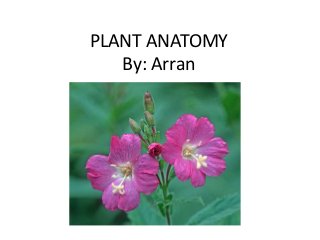Recommended
More Related Content
Viewers also liked
Viewers also liked (16)
More from Rorey Risdon
More from Rorey Risdon (8)
Grade 3 Open House International School of Tanganyika

Grade 3 Open House International School of Tanganyika
Plant anatomy
- 2. SEEDS The seed starts the plant cycle.
- 3. ROOTS Roots are the part of the plant that collects water for the plant to grow. The roots also have more than one job, they help the plant stay in one spot during erosion.
- 4. STEM The stem supports the plant so that the plant doesn't fall over. Another thing the stem does is it takes the water from the roots and sends it to the rest of the plant.
- 5. LEAVES The leaves only have one job and that job is to gather sunlight for the plant.
- 6. FLOWER The flower looks and smells nice to attract bees and other insects so that they come and visit them to take their pollen to another flower of the same kind to make a seed.

